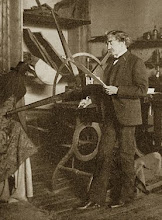
In almost every way I was very fortunate when I got my Kelton press. Two bed support rollers were broken one of the handles on the starwheel was missing. I was able to have new rollers machined and the handle replaced. The weight that returns the table to the front position was also missing and a lot of cleaning was required. But in terms of having an operating press, these were small issues and otherwise it seemed complete. It even had the felt blanket operating system attached, something that was not attached to every press to begin with and that is usually missing in any case. It wasn't until I saw a video on Youtube and then later a museum photo that I learned that there had originally been a side table.
While not at all an essential part I did think that such a table would be useful to me because of the limitations on space in my living room shop. There is little room for a work table and I already use my letterpress imposing table for the plate heater and ink slab. Besides, another part of me thought it would be great to have the table and make the press complete. Yeah, right; good luck finding one!
Well, I did find one. A couple months ago I was reading a blog post by a fine arts student who was restoring an identical Kelton press. He did a beautiful job by the way and his press works great. In one of the photos I happened to notice a large, black, rectangular object on the floor in the background. I looked closer, zoomed in, and was pretty certain it was one of the tables. I wrote him and he confirmed that it was. I asked him if he was going to use it and if not would he care to sell it. To make a long story short, it came UPS a week and a half ago and I couldn't be happier or more grateful to him.

As I had seen from the Youtube and museum photo, the table was supported on one side by flat iron bar which was missing. I was able to fabricate a replacement with little trouble and it is visible in the attached photos. Otherwise it is attached by two machine screws to the side of the press. At about 70 pounds it is quite heavy.
I don't yet know if the manufacturer had intended specific uses for the different sections on the table though two are fairly obvious: The lowered tray on the left front is for caulk, the front of the compartment partially cut out for clearance of the hand as it is brushed over the top of the caulk. The flat section on the right front seems to be for use as a jigger while wiping the plate. I don't know exactly what the intention was for the two upper sections but possibly for tarlatan, pieces of blotting or other paper, etc. They may not have any specific purpose, just handy areas for whatever the press operator wanted based on his own working methods. The photo below shows things as they might be in use and as I will likely use them, though one of the rear upper sections will be used for blotting paper to lay over and under prints when pulling prints.

I'll be trying this setup soon as I print an edition for an upcoming print exchange.


+With+Press+cropped.jpg)


